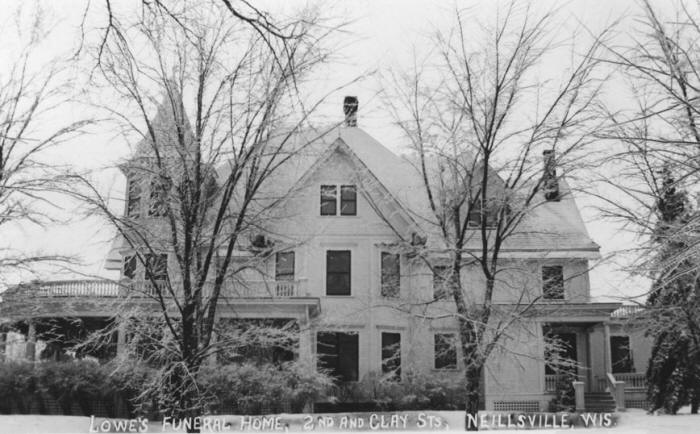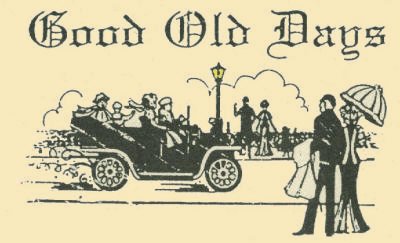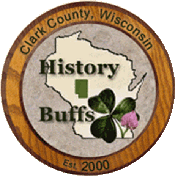|
|
|
Clark County Press, Neillsville, Wisconsin March 21, 2012, Page 11 Contributed by "The Clark Co. Press" Transcribed by Dolores (Mohr) Kenyon. Index of "Oldies" Articles
Compiled by Dee Zimmerman
Clark County News |
February 1937
History of Logging in Clark County
By Fred Draper
Chapter VII
After reaching the landing the logs were unloaded by the landing crew and if the landing was small the logs were sometimes decked high with a decking chain and team.
The usual procedure was to have landing space enough so that the landing crew would roll the logs up by and with the aid of spiked skids. The bed of the creek or river and the ice on the flood dam was also made use of as a landing.
The logs were all side marked by the landing men by cutting the owners mark through the bark and into the timber on the side of the log about equal distance from the ends.
All kinds of marks were used, sometimes the initials of the owners as C.L.C., the C. L. Coleman Lumber Company. Of course the lumberjack’s interpretation of these letters, which the Coleman’s also used on their harness and camp kit in general, to the boys who always declared that the letters stood for Coleman’s Lousy Crew.
Hewett and Woods used H.W. and sometimes a large mark cut in the bark and three smaller ones extending diagonally from right to the left from the large notch and when they used this mark for a side mark they used a barred S for an end mark that looked much like a $ sign.
The Crosby Lumber Company use a letter V with another V bottom side up and crossing the first.
Another mark was XIX, which I believe was used by Robert Schofield. When the logs from all of the tributaries got in the main river; below the mouth of the East Fork there were hundreds of different marks. Each logger or contractor had his own particular mark.
After the logs were in the rollway and marked with the side mark they were scaled by the scaler who used a Scribner log rule. As the logs were scaled he stamped the log with an end mark, which was usually the same as the side mark. The stamp was a cast iron hammer with the letters or design cast in the end and weighed in the neighborhood of three pounds.
After the spring “break-up” came, there was usually two or three weeks before the ice broke sufficiently in the streams for the drive to start, the gates to the flood dams were closed to keep a head of water, the loggers always hoped that the break up would come with a rain but sometimes the snow went away gradually and the early April rains failed to come in sufficient quantity. When that happened most of the logs were left high and dry on the landing and sometimes those that were landed on the ice were left on the banks and sand bars before they reached La Crosse, then there was nothing to do but to wait for the June rains.
In this connection is told a story of W. T. Price, one of Clark County’s earliest and largest loggers.
It happened at the time the Methodists were building their church at Black River Falls and some of the building committee went to Price and asked him for a donation towards building the church. Price said, “I can’t give you anything now, we didn’t have any drive this spring and my logs are all tied up on the East Fork, but if you Methodists will pray for rain and I am able to get my logs out I will give the church $500. Along in June the rains descended and the floods came and Price’s logs went down the river, after he returned from the drive the committee again waited on him for his donation.
Price turned to his desk and wrote them a check for $500 and handed it to the committee and said, “The trouble with you Methodists is that you pray too damned hard, you’ve scattered my logs on the banks and up the sloughs all of the way from the East Fork to La Crosse.”
When the ice began to break up on the streams it was time to start the drive. The gates on the flood dams were opened and the logs that were landed on the ice were driven out first, then came the work of breaking the rollways, the blocks which held back the first logs nearest the bank were knocked and where the logs were piled as they sometimes were when the first log started, the whole top of the rollway came tumbling down like an avalanche and into the water with a might splash. The work was dangerous and the men who broke rollways had to be quick of eye and quick of foot and only experienced men were set at that work, even then some were either killed or maimed for life. I knew one man who had an ear taken off close to his head as a log rolled past him, before he had the time to get entirely out of the way.
After the rollways were broken, the work came of rolling the remaining logs with cant hooks into the stream. After the dams had been emptied of water the gates were closed to fill the dam for a new flood and as the water raised many of the logs that had stranded along the sand her and there on the banks above the dam, floated, but there were always more or less above the back waters of the dam that were in shallow water and these had to be rolled into deeper water where they would float and to do this the men had to work in the icy water sometimes up to their waists, this was called sacking.
(To be continued)
•••••••••
Irvin Carl recently purchased the Tony Barr blacksmith shop at Greenwood and will begin work in his new location Monday, having spent several days at Greenwood preparing for the opening.
In 1911, at the age of 15, Mr. Carl began work for Korman & Sommerfeld, later working for Korman and Ghent and for the past 21 years he has been in the same shop. He spent one year overseas, has been a member of the Otto A. Haugen Post of the American Legion Post since its organization and served for 20 years with Neillsville Fire Department. In 1921, he built a modern home on East 9th Street and the following year he was married to Ida Wieting of this city.
Mr. and Mrs. Carl have three sons and one daughter; Robert is a 7th grader in St. John’s Lutheran School, and Harland began his kindergarten work in the North Side School this year.
Mr. Carl is highly esteemed by a large circle of friends and by all with whom he came in contact in a business way.
Mrs. Carl and children will remain here until school closes when they plan to rent a house at Greenwood and join Mr. Carl in their new home. The entire family will be greatly missed in this city, but the well wishes of friends will follow them in their venture.
•••••••••
The construction of a dam on Wedge’s Creek on the Ernest Snyder property under a WPA project is considered likely following action taken by the Clark County Board in approving the plan. Mr. Snyder has given the county an easement deed to the property involved. It is proposed to make the spot a swimming and recreational center. The project has received the endorsement of the Junior Chamber of Commerce.
•••••••••
Monday night a group of men headed by Wm. A. Campman met to devise a means where by Neillsville may continue to have a golf course.
It was decided to incorporate for $10,000 and sell stock in the company at $100 a share. No more stock will be sold than is necessary to start with a clean sheet. It is hoped that those who purchase stock will do so with the idea of helping Neillsville and not with the intention of making any money, although it is felt that there is no reason why the golf course cannot be made to pay a profit. Interest in golf has grown by leaps and bounds the past year. Stockholders will, of course, be required to pay dues the same as playing members. This will be the same as last year, $25 per year for a man and all minor members of his family.
The course us being purchased at what is said to be an unbelievably low figure, $4,000, and it is hoped all public spirited citizens will step into the breach, whether they play golf or not, to help preserve this wonderful asset for the community.
•••••••••
The Motor Inn garage at Owen has been purchased by the Clark County Board for $4,184.49 at its special meeting Monday. The garage is to be used to house highway machinery in the north end of the county, which is now kept in a rented quarter. It is planned to keep a mechanic there during the winter to make repairs on snow removal equipment.
•••••••••
The State Conservation Department has approved the Granton American Legion game refuge in the Town of York, described as: Township 25 North, Range 1 West Section 36 entire Section.
•••••••••
Marriage Licenses issued:
Arthur Dominie and Hazel Strey, Town of York
Elton D. Collier and Mabel Isabel Riddle, Owen;
Joseph Mertens, Hixon and Hilda Rasmussen, Longwood
March 1947
Mrs. Ruth Wage widow of Fernando Wage both of whom were pioneer residents of Clark County observed her ninety-fifth birthday anniversary on Feb. 28, at the home of her grand niece, Mrs. George Haskins, where she resides. Mrs. Wage came to this country in 1867 and has resided here ever since with the exception of about 18 months, when she and her husband were living in Centralia, Wash. In the early days Mr. Wage was engaged in the lumbering industry along the Black River. They had a farm in Pine Valley and also lived for a time in the Town of Grant. She often went with her husband to live in the lumber camps. Mr. Wage died in 1926 and for the past fifteen years she has lived with Mr. and Mrs. Haskins.
Mrs. Wage was born in Brandt County, New York. At the age of five years she came with her mother to Cataract, Wis., as her father having died when she was a baby. At Cataract they joined Joel and Almira Head, her brother-in-law and sister. Four years later her mother died and she continued to live with Mr. and Mrs. Head, coming with them to this county when she was fifteen years of age. Mr. and Mrs. Head were the grandparents of Mrs. Haskins and are well remembered by the older residents of this community.
Mrs. Wage became a country schoolteacher, her first school being the Ackerman or Beyer School in the Town of Pine Valley. In later years this was also Mrs. Haskins’ first school of Minnie Tolford, who was Mrs. Haskins’ first teacher.
Though Mr. and Mrs. Wage had no children of their own, they had been like a father and mother to many children who needed help and often took them into their home to care for them. They adopted one son, John, who died in 1905, while a student at the Neillsville High School.
Of late years Mrs. Wage’s eyesight has failed and she has been forced to give up much of the reading, to which she had been accustomed to, but her general health is good and she is able to be about the house every day.
•••••••••
The people of the Heathville School district held a special meeting and voted to close their school next year and transport their pupils to the Romadka State Graded School. County Superintendent Russell Drake attended the meeting.
(The Heathville School was located 2 miles east and ½ mile north of the Romadka School, or ½ mile north of County Road ‘H’ on Heath Road, in the Town of Fremont. D. Z.)
•••••••••
The most sought after people in Neillsville last week were Mr. and Mrs. George Hubing.
The reason was that they have bought the large Lowe funeral home building, at the corner of South Clay and Second streets, for the purpose of remodeling it into apartments.
Word travels rapidly in a small community, especially word of housing possibilities. The result has been that the Hubing’s were deluged with application for apartments.
“If we were to have three times as many apartments as we plan,” Mrs. Hubing remarked two days after the purchase, “we would have them all rented.”
The Hubings plan to remodel the house into either five or six apartments. Comparatively little work will be required, Mrs. Hubing said, and they will proceed with the work as rapidly as possible.
Plans of Mrs. Ella C. Lowe, former owner, and her sons, who have been associated with her in the business, have not been announced. They retain the furniture business and will continue the undertaking business in the present location until they turn over possession of the house to the Hubings.
The Lowe house was built in 1909 by Charles Cornelius, founder, the first president and cashier of the First National Bank. The erection of the home was carried out during the time the present building of the bank was under construction.
A history of Clark County published in 1918 said of it:
“This beautiful structure is the handsomest residence in Clark County. It is finished in colonial style and furnished with every comfort and convenience that good taste can devise.”
•••••••••
Fire completely destroyed the Holmes store building at Fairchild Monday night. The loss included Gilbert Holmes’ stock of groceries and general merchandise, the building and the incomplete locker plant, which was being installed there by Louie Primus. The loss to Mr. Holmes is estimated at $3,000. The loss to Mr. Primus, who owned the building, is several times that. Mr. Holmes was adequately insured; Mr. Primus at least partially.
•••••••••
The creation of a flowage of approximately 300 acres by damming the Eau Claire River in section 28, Town of Mead, was taken under consideration this week.
The area is located about 10 miles northwest of Greenwood in the Clark County forest area. It is the location of a log and earthen dam used for logging operations until about the turn of the century. Some of the earthen fill and log pilings of the old time logging dam remain on one of two sites proposed for the construction of the dam.
The backwater of a 14-foot dam at this point would create a lake of about twice the area of that made by Rock Dam near Willard. It would be developed as a public recreational ground. Muskie, pike and bass would be planted in the lake to make it an attractive fishing spot.
•••••••••
You don’t have to catch fish, when you can eat them on Friday Nights at John Lato’s Tavern.

|
The Charles Cornelius house, along with a carriage house, was built in 1909 on the corner of the 200 Clay Street block, and was graced with floral gardens and walkways filling the remainder of the block’s area, with the townspeople being invited to stroll through the gardens to enjoy the scenic display of flowers during the summer seasons. |
¤¤¤¤¤¤¤¤¤¤¤

